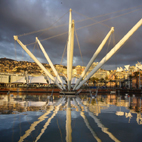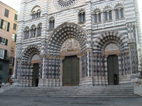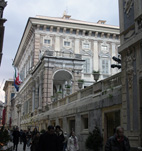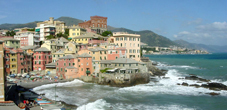Genova may not be as famous as other Italian historic cities but its particular location between sea and mountains and its long history make it a unique town, worth of a visit.
The Porto Antico ( "old harbor" in Italian) is the ancient part of the port of Genova. The italian architect Renzo Piano recently renovated the area, restoring the historical buildings (like the Cotton warehouses) and creating new landmarks like the Aquarium, the Bigo and recently the "Bolla" (the Sphere). The main tourist attractions of this area are the Aquarium, the Museum of the Sea, the City of Children and the Museo Luzzati. The port of Genova also contains an ancient lighthouse, called the "La Lanterna" (i.e., "the lantern"). |
The area of the old harbor is surrounded by the historical center, the largest in Europe with its dedalus of narrow alleys (called caruggi) and small squares. Parts of the medieval walls and gates built to defend the town are still visible. Within this area, the points of historical and artistic interest are numberless: we can just mention Palazzo San Giorgio, seat of the Port Authority since it was built in the Middle Age, the Cathedral of San Lorenzo, consecrated in 1118, the Palazzo Ducale, where the Duke of the ancient Genova Republic had his seat and the house where Christopher Columbus is said to have been born. |
A very interesting collection of sculptures and paintings testifying the evolution of religious art in the middle ages can be seen in the Museo of Sant'Agostino housed within an Augustinian convent complex that dates back to the eighth century. |
|
The XVIII and XIX centuries saw the expansion of the North-East side of the town: of that period are piazza de Ferrari, with the Opera Theatre (Teatro Carlo Felice), via XX Settembre, via Roma, Galleria Mazzini and the surrounding streets that represent the most elegant part of the town with shops and cafes. Above the portico of via XX Settembre you will see the Church of Santo Stefano, built on the ruines of a church of the V century and considered one of the most significant examples of Romanic architecture. |
Moving to the East, after the mouth of the Bisagno River, is Corso Italia, a promenade which runs for 2.5 kilometres in the quartiere of Albaro, linking the two other neighborhood of Foce and Boccadasse. The promenade, which was originally built in 1908, overlooks the sea, towards the promontory of Portofino. The main landmarks are the small lighthouse of Punta Vagno, the San Giuliano Abbey, the Lido of Albaro.The Physics Department is located on the hill beneath Albaro. |
More information can be found on the site of Comune di Genova, APT of Genova and in many other sites (1, 2...), or in the tourist's offices in the town. A map of the town center and tourist guide will be prepared for every participant to the Meeting.



